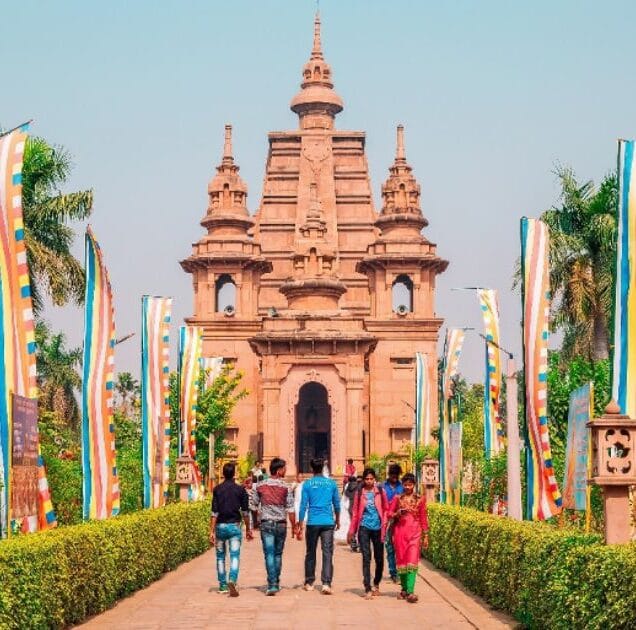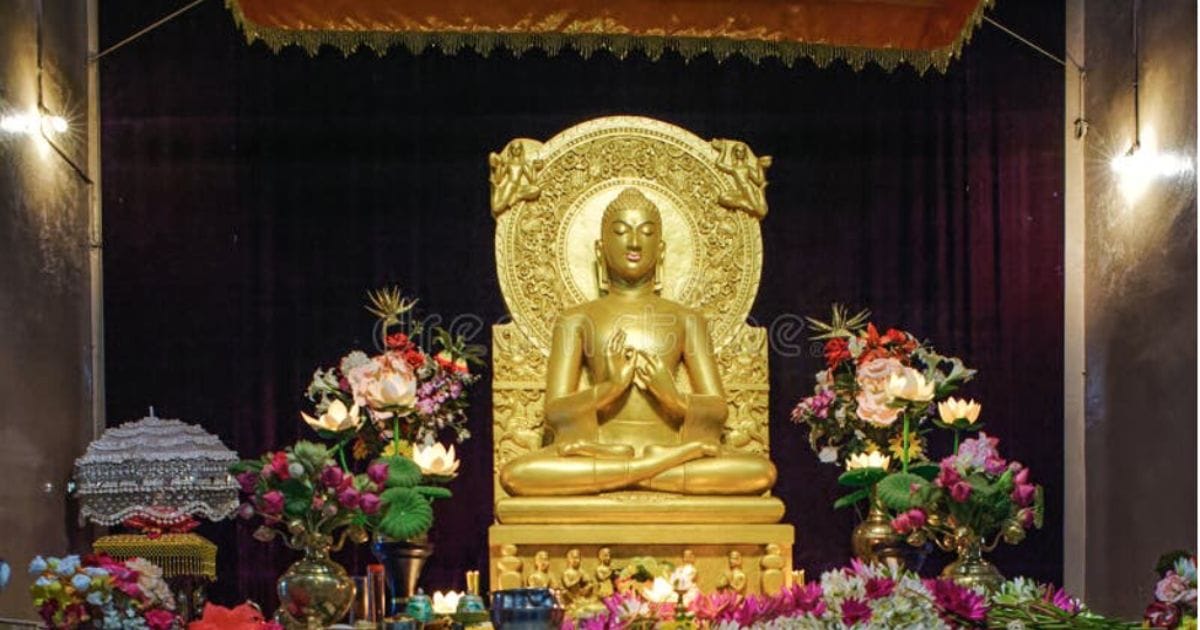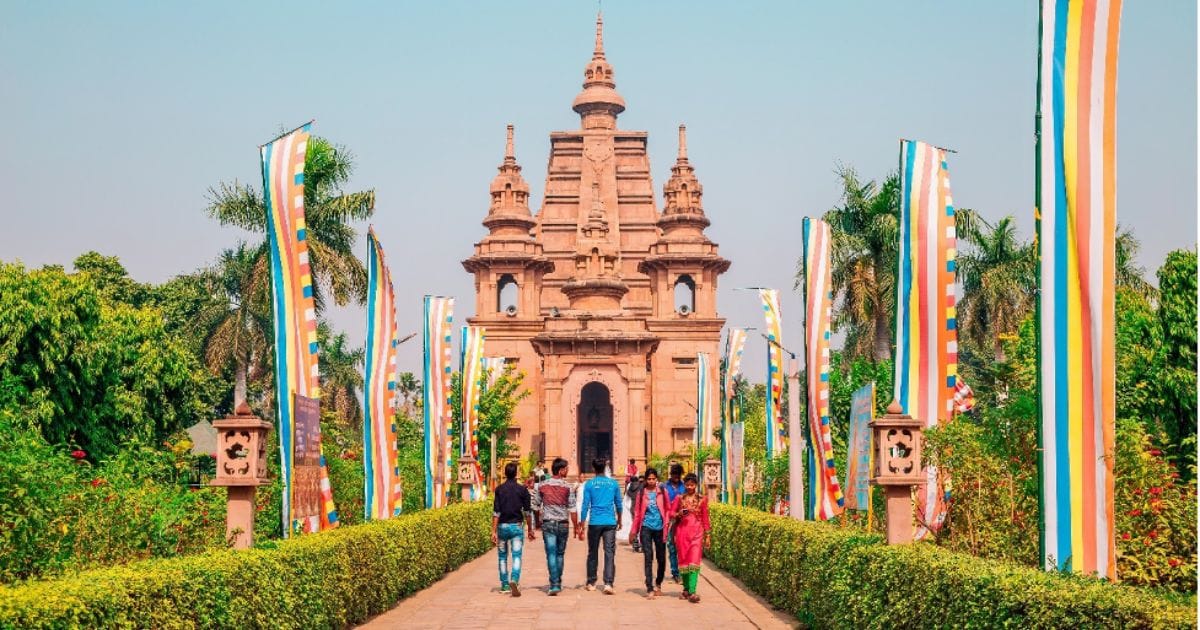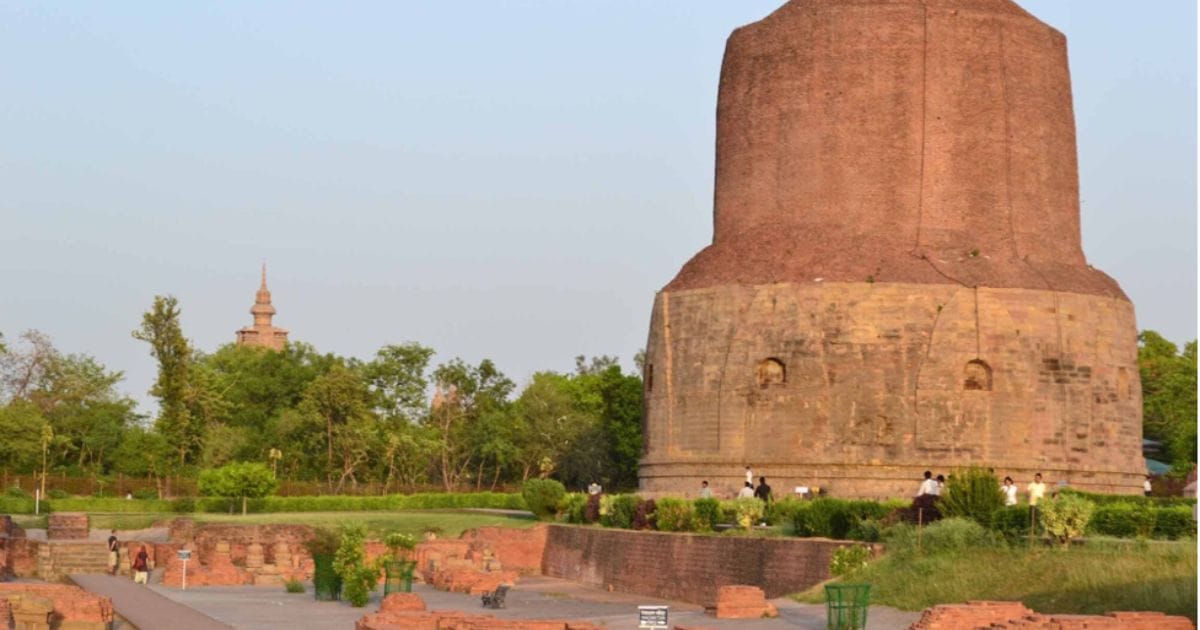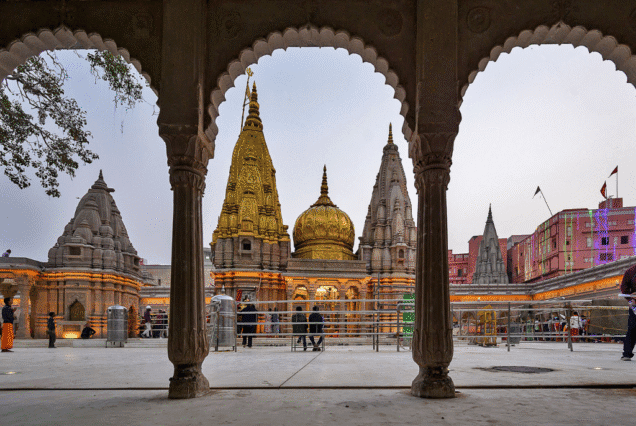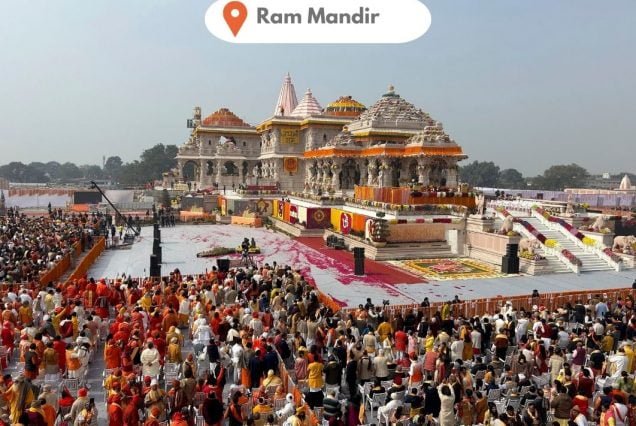Sarnath: The Sacred Birthplace of Buddhism and Your Complete Travel Guide
Have you ever stood at a place where a single moment changed the course of human history? Welcome to Sarnath, a small town just 13 kilometers from Varanasi that witnessed one of the most significant events in world religion – Buddha’s first sermon over 2,500 years ago. This isn’t just another archaeological site; it’s the sacred ground where Buddhism took its first breath and began its journey to become one of the world’s major religions.
Imagine walking through the same deer park where Prince Siddhartha, having achieved enlightenment, chose to share his profound insights with five ascetic companions. Today, pilgrims from across the globe come to Sarnath not just to see ancient ruins, but to experience the spiritual energy that still permeates this holy site. But what exactly happened here that made this small patch of land so monumentally important?
Introduction to Sarnath
Sarnath, originally known as “Sarangnath” (Lord of the Deer), represents the birthplace of the Buddhist Sangha (community of monks) and the spot where the Dharma (Buddhist teachings) was first proclaimed to the world. This UNESCO World Heritage site combines archaeological magnificence with spiritual significance, making it one of the four most important Buddhist pilgrimage destinations alongside Lumbini (Buddha’s birthplace), Bodh Gaya (site of enlightenment), and Kushinagar (place of Buddha’s passing).
What makes Sarnath particularly fascinating is how it seamlessly blends ancient history with living faith. While you can explore 2,500-year-old stupas and monastery ruins, you’ll also encounter modern Buddhist temples from various countries, each reflecting different cultural interpretations of Buddha’s teachings. The result is a unique spiritual ecosystem where past and present coexist harmoniously.
The site attracts not only Buddhist pilgrims but also history enthusiasts, archaeology lovers, and anyone seeking peace in our chaotic modern world. The serene atmosphere, combined with the weight of historical significance, creates an environment where visitors often find themselves naturally drawn to contemplation and reflection.
Sights
Map
Info
Historical Significance of Sarnath
Buddha’s First Sermon at Deer Park
Why did Buddha choose this particular location for his first teaching? After achieving enlightenment under the Bodhi tree in Bodh Gaya, Siddhartha spent several weeks in meditation, initially hesitant to share his profound realizations. The teachings seemed too complex, too subtle for ordinary minds to grasp. However, divine intervention (according to Buddhist texts) convinced him that some beings with “little dust in their eyes” could indeed understand and benefit from the Dharma.
The Deer Park at Sarnath became his chosen venue because it was here that five ascetics – his former companions who had earlier abandoned him when he gave up extreme austerity – were living. These five men, named Kondanna, Bhaddiya, Vappa, Mahanama, and Assaji, initially refused to acknowledge the Buddha, believing he had given up the spiritual path by accepting food and ending his severe penances.
The Turning of the Wheel of Dharma
What happened during that first sermon that changed everything? The event, known as “Dhammacakkappavattana” or “Turning of the Wheel of Dharma,” introduced concepts that would reshape human understanding of suffering, existence, and the path to liberation. Buddha presented the Four Noble Truths and the Noble Eightfold Path – fundamental teachings that remain central to Buddhist philosophy today.
The metaphor of “turning the wheel” is particularly significant. In ancient Indian culture, a wheel represented completeness, continuity, and royal authority. By using this imagery, Buddha indicated that his teachings formed a complete system of spiritual development that would continue rolling forward through time, transforming countless lives along the way.
The Five Disciples and Early Buddhist Community
These five ascetics became Buddhism’s first monks, forming the original Sangha. Their conversion wasn’t immediate – it took several days of teaching and discussion before they fully accepted Buddha’s insights. Kondanna was the first to achieve enlightenment, followed by the others, creating the foundation of the Buddhist monastic community that continues to this day.
This small group’s transformation demonstrates an important Buddhist principle: the teachings spread not through force or dramatic miracles, but through reasoned discourse, personal example, and the gradual recognition of truth. The democratic spirit of that first discussion set a precedent for how Buddhist teachings would be transmitted throughout history.
Archaeological Wonders of Sarnath
The Great Dhamek Stupa
Standing majestically at 43.6 meters high and 28 meters in diameter, the Dhamek Stupa dominates Sarnath’s landscape like a silent guardian of ancient wisdom. But why does this massive cylindrical structure hold such significance? Built during the Gupta period (5th-6th century CE) on the foundation of an earlier Mauryan stupa, it marks the exact spot where Buddha delivered his first sermon.
The stupa’s architecture tells a story of devotion spanning centuries. Its solid brick construction, decorated with intricate stone carvings featuring floral and geometric patterns, represents one of the finest examples of Gupta-era Buddhist architecture. The structure was designed not just as a monument, but as a three-dimensional mandala – a sacred space that devotees could circumambulate while contemplating Buddha’s teachings.
What strikes visitors most is the stupa’s imposing yet peaceful presence. Unlike many ancient monuments that feel museum-like, Dhamek Stupa remains alive with spiritual energy. Pilgrims from Tibet, Sri Lanka, Thailand, Myanmar, and other Buddhist countries regularly perform kora (circumambulation) around its base, continuing a tradition that has persisted for over a millennium.
Chaukhandi Stupa and Its Unique Architecture
Just a short walk from the main complex stands the Chaukhandi Stupa, notable for its unusual octagonal tower topped by a Mughal-era structure. This monument marks the spot where Buddha first met his five disciples after achieving enlightenment. The combination of ancient Buddhist architecture with later Islamic additions creates a unique aesthetic that reflects Sarnath’s long, layered history.
The octagonal tower, added much later during Akbar’s reign to commemorate his father Humayun’s visit to Sarnath, demonstrates how different rulers and cultures have honored this sacred site throughout history. This architectural fusion symbolizes the universal appeal of Buddha’s message across cultural and temporal boundaries.
Ancient Monastery Ruins
Scattered throughout Sarnath are the remains of numerous monasteries that once housed thousands of monks. These ruins reveal a sophisticated monastic community that flourished for over 1,500 years. Walking through these ancient foundations, you can almost visualize the daily life of monks who studied, meditated, and preserved Buddhist teachings through centuries of political upheaval.
The monastery layouts follow traditional Buddhist architectural principles, with meditation halls, living quarters, libraries, and stupas arranged to support both individual practice and community life. Archaeological evidence suggests that Sarnath was not just a pilgrimage site but a major center of Buddhist learning, attracting scholars from across Asia.
Museums and Cultural Treasures
Sarnath Archaeological Museum
Housing one of India’s finest collections of Buddhist art and artifacts, the Sarnath Archaeological Museum serves as a treasure trove of ancient Buddhist culture. But what makes this relatively small museum so significant? It contains original sculptures, inscriptions, and artifacts discovered during excavations at Sarnath, providing tangible connections to the site’s glorious past.
The museum’s collection spans from the 3rd century BCE to the 12th century CE, documenting the evolution of Buddhist art and thought over nearly 1,500 years. Each artifact tells a story – from simple pottery used by monks in their daily lives to elaborate sculptures that adorned monastery walls.
The Famous Lion Capital
The museum’s crown jewel is the original Ashoka Lion Capital, discovered in 1905. This masterpiece of Mauryan art, dating to the 3rd century BCE, served as the inspiration for India’s national emblem. Why would Emperor Ashoka choose this particular design for his pillar at Sarnath? The four lions, standing back-to-back, symbolize the spread of Buddha’s teachings in all four directions.
The capital’s base features a wheel (dharma chakra) flanked by a bull, a lion, an elephant, and a horse – representing different aspects of Buddhist cosmology and the ruler’s authority. The craftsmanship is so exquisite that even after 2,300 years, every detail remains sharp and expressive, testament to the skill of ancient Indian artisans.
Ancient Sculptures and Artifacts
Beyond the famous Lion Capital, the museum houses an impressive collection of Buddha images representing different artistic periods and styles. Each sculpture reflects not just artistic evolution but also changing theological interpretations of Buddha’s nature and teachings.
Particularly noteworthy are the Gupta-period Buddha statues, considered by many art historians to represent the pinnacle of Buddhist sculptural art. These images perfectly balance idealism with naturalism, creating faces that radiate both human warmth and transcendent wisdom.
Modern Temples and Spiritual Centers
Mulagandha Kuti Vihara Temple
Built by the Mahabodhi Society in 1931, the Mulagandha Kuti Vihara represents modern Buddhist architecture at its finest. But why was this temple built when ancient stupas already marked the sacred spots? The temple serves as a functioning center for Buddhist worship and meditation, providing facilities that the ancient monuments, preserved as archaeological sites, cannot offer.
The temple’s name, meaning “fragrant chamber,” refers to the hut where Buddha supposedly stayed during his visits to Sarnath. Inside, beautiful frescoes painted by Japanese artist Kosetsu Nosu depict scenes from Buddha’s life, creating a visual narrative that helps visitors understand Buddhist history and philosophy.
Thai Temple and International Buddhist Community
The presence of multiple international temples at Sarnath reflects Buddhism’s global reach and the site’s continuing relevance to practitioners worldwide. The Thai Temple, with its distinctive Southeast Asian architecture, creates a striking contrast to the ancient Indian monuments while maintaining perfect harmony with the site’s spiritual atmosphere.
These international temples serve practical purposes beyond symbolism. They provide accommodation for pilgrims from their respective countries, offer teachings in various languages, and demonstrate how Buddha’s universal message has been adapted to different cultural contexts while maintaining its essential character.
Tibetan Temple and Monastery
The Tibetan Temple and Monastery, established by Tibetan refugees, brings the distinctive architectural and spiritual traditions of Himalayan Buddhism to Sarnath. The presence of Tibetan monks, with their maroon robes and distinctive chanting style, adds another layer to Sarnath’s multicultural Buddhist community.
This temple particularly emphasizes the Mahayana Buddhist tradition’s interpretation of Buddha’s teachings, offering visitors exposure to different schools of Buddhist thought that all trace their origins back to that first sermon in Deer Park.
Best Time to Visit Sarnath
Seasonal Weather Patterns
When should you plan your pilgrimage to Sarnath for the most meaningful experience? The site’s location in the Gangetic plain means it experiences three distinct seasons, each offering different advantages for visitors. Winter months (November to February) provide the most comfortable weather for extensive outdoor exploration, with pleasant temperatures ranging from 5°C to 25°C.
Spring (March to April) offers ideal conditions for photography, with clear skies and moderate temperatures highlighting the monuments’ architectural details. The gardens around the temples bloom during this period, creating a naturally beautiful setting that complements the spiritual atmosphere.
Festival Times and Special Occasions
Planning your visit around Buddhist festivals can enhance your experience significantly. Buddha Purnima (the full moon day in April/May) commemorating Buddha’s birth, enlightenment, and parinirvana attracts thousands of international pilgrims to Sarnath. The atmosphere during this festival is electric with devotional energy, special prayers, and cultural programs.
Dhammacakka Day, specifically celebrating the first sermon at Sarnath, typically falls in July and features special ceremonies at the Dhamek Stupa. While monsoon rains might affect outdoor activities, the spiritual intensity of this commemoration often creates profoundly moving experiences for participating pilgrims.
How to Reach Sarnath from Varanasi
Distance and Transportation Options
The journey from Varanasi to Sarnath covers just 13 kilometers, making it an easy day trip or even a half-day excursion. But which transportation option best suits different types of travelers? The short distance means you have multiple convenient choices, each offering different experiences and price points.
By taxi or private car, the journey takes approximately 30-45 minutes depending on traffic. This option provides comfort and flexibility, allowing you to travel at your own pace and make stops for photography or refreshments along the way.
Local Transport and Rickshaw Services
Auto-rickshaws offer an economical and authentic way to reach Sarnath, though the journey might take slightly longer due to their slower speed and tendency to make frequent stops. Many visitors enjoy this option as it provides closer contact with local life and culture during the journey.
Bus services connect Varanasi and Sarnath regularly throughout the day, offering the most budget-friendly transportation option. While buses can be crowded and less comfortable, they provide opportunities to interact with local pilgrims and experience public transportation in India.
Guided Tour Options
Professional guided tours combine transportation with expert commentary, making them ideal for visitors who want to maximize their understanding of Sarnath’s significance. TripCosmos.co offers comprehensive packages that include not just transportation but also knowledgeable guides who can explain the historical and spiritual significance of each site.
These guided experiences often include visits to both the archaeological sites and modern temples, providing a complete picture of Sarnath’s evolution from ancient pilgrimage center to contemporary spiritual destination.
Accommodation Options Near Sarnath
Budget Stays and Guesthouses
For travelers seeking affordable accommodation near Sarnath, several guesthouses and budget hotels provide clean, basic facilities without breaking the bank. Many of these establishments are run by local families or religious organizations, offering authentic hospitality alongside economic rates.
Some Buddhist temples also provide accommodation for serious practitioners or pilgrims, though these options typically require advance booking and adherence to temple routines and rules. The experience, however, can be deeply enriching for those genuinely interested in Buddhist practice.
Mid-Range Hotels
Mid-range accommodations near Sarnath balance comfort with reasonable pricing, often featuring amenities like air conditioning, attached bathrooms, and on-site restaurants. Many of these hotels cater specifically to international Buddhist pilgrims, providing services and facilities that support contemplative stays.
Several properties offer rooms with views of the Dhamek Stupa or other monuments, allowing guests to maintain visual connection with the sacred sites even while resting. Some hotels also organize early morning meditation sessions or evening dharma talks for interested guests.
Things to Do in Sarnath
Meditation and Spiritual Practices
What better place to practice meditation than the spot where Buddha first taught the path to enlightenment? Several locations within Sarnath offer ideal settings for contemplative practice. The area around the Dhamek Stupa, particularly during early morning or late afternoon, provides a peaceful environment for sitting meditation.
Many visitors find that simply walking mindfully around the monuments becomes a form of moving meditation. The practice of circumambulation, traditional in Buddhist culture, allows for meditative focus while honoring the sacred nature of the site.
Photography and Sightseeing
Sarnath offers photographers subjects ranging from ancient architecture to contemporary spiritual life. The interplay between old and new – ancient stupas alongside modern temples, traditional monks in historical settings – creates compelling visual narratives.
The golden hour lighting, just after sunrise or before sunset, transforms the monuments into subjects of extraordinary beauty. The Dhamek Stupa, in particular, becomes almost luminous during these times, providing opportunities for both artistic and documentary photography.
Walking Tours and Heritage Trails
Self-guided walking tours allow visitors to explore Sarnath at their own pace while following trails that connect all major sites. The compact nature of the archaeological area makes walking the most practical way to see everything while maintaining the contemplative mood appropriate to this sacred site.
Heritage trails often include not just the famous monuments but also lesser-known ruins, inscriptions, and architectural details that casual visitors might miss. Taking time to examine these elements provides deeper appreciation for the site’s historical complexity.
Local Food and Dining Options
The area around Sarnath offers various dining options that cater to the diverse dietary requirements of international pilgrims. Many restaurants specialize in vegetarian cuisine, respecting the dietary preferences of Buddhist visitors while also serving Indian travelers who may follow vegetarian diets for religious reasons.
Local specialties include traditional Buddhist-influenced dishes that avoid strong spices and garlic, focusing instead on simple, nourishing ingredients. Many establishments also serve Tibetan momos, Thai curries, and other Asian dishes that reflect the international Buddhist community’s presence.
Shopping for Buddhist Artifacts and Souvenirs
Sarnath’s shops offer an array of Buddhist-themed items ranging from simple prayer beads to elaborate statues and thangka paintings. Many items are crafted by local artisans who have inherited traditional techniques for creating religious art and artifacts.
Popular purchases include small Buddha statues, prayer wheels, meditation malas, and books on Buddhist philosophy. When shopping for religious items, it’s important to buy from reputable dealers who can guarantee the authenticity and quality of their products.
Nearby Attractions and Day Trip Options
Sarnath’s proximity to Varanasi makes it easy to combine your visit with exploration of other significant sites. The ancient city of Varanasi itself deserves at least a day, with its famous ghats, temples, and cultural attractions providing contrast to Sarnath’s specifically Buddhist focus.
Other nearby destinations include Chunar Fort, known for its historical significance, and various rural villages where traditional crafts are still practiced. These excursions provide broader context for understanding the region’s cultural heritage.
Cultural Etiquette and Visitor Guidelines
Visiting Sarnath requires sensitivity to its sacred nature and respect for the religious practices of pilgrims from various Buddhist traditions. Dress modestly, covering shoulders and legs, and remove shoes when entering temple buildings or sitting on the ground near stupas.
Maintain quiet, respectful behavior throughout the site, remembering that many visitors are engaged in prayer, meditation, or other spiritual practices. Photography should be done discretely, and always ask permission before photographing people, especially monks or pilgrims engaged in religious activities.
Photography Rules and Restrictions
While photography is generally permitted in the outdoor archaeological areas, specific restrictions apply to museum interiors and some temple spaces. The Archaeological Survey of India requires permits for professional photography, and tripods may require special permission.
Flash photography is prohibited in most indoor spaces to protect ancient artifacts and paintings. Always check current photography policies at each location, as rules can change and may vary between different temples and institutions.
Conclusion
Sarnath stands as more than just a historical site or tourist destination – it’s a living testament to the transformative power of wisdom and compassion that Buddha first shared with the world over 2,500 years ago. Walking through the Deer Park where Buddhism began, standing before the mighty Dhamek Stupa, and experiencing the continued devotion of pilgrims from around the globe creates a profound connection to one of humanity’s greatest spiritual traditions.
Whether you approach Sarnath as a Buddhist pilgrim, a history enthusiast, or simply a traveler seeking meaningful experiences, this sacred site offers something that transcends ordinary tourism. The combination of archaeological wonders, spiritual energy, and international community creates an environment where past and present merge, offering insights into both human history and the timeless quest for understanding and peace.
Your journey to Sarnath becomes part of an unbroken chain of pilgrims stretching back 25 centuries – each seeking, in their own way, the wisdom and peace that Buddha first offered under the trees of Deer Park. In today’s turbulent world, perhaps we need Buddha’s message of compassion and understanding more than ever, making Sarnath not just a window into the past, but a beacon of hope for the future.
Frequently Asked Questions (FAQs)
Q1: How much time should I allocate for visiting Sarnath? A thorough visit to Sarnath typically requires 3-4 hours to see all major sites including the Dhamek Stupa, museum, and various temples. However, many visitors prefer to spend a full day to allow time for meditation, reflection, and unhurried exploration of the site’s spiritual atmosphere.
Q2: Are there any entrance fees for Sarnath’s attractions? The Archaeological Survey of India charges a nominal entrance fee (₹15 for Indians, ₹200 for foreigners) for the main archaeological site and museum. Individual temples may have their own policies, though most are free to enter. Camera fees may apply for photography in certain areas.
Q3: Can I participate in meditation sessions at Sarnath? Yes, several temples and meditation centers in Sarnath offer regular meditation sessions, particularly the Mulagandha Kuti Vihara and various international temples. Some sessions are scheduled daily, while others occur on special occasions. It’s advisable to inquire locally about current schedules.
Q4: Is Sarnath suitable for visitors who are not Buddhist? Absolutely. Sarnath welcomes visitors of all backgrounds and beliefs. The site’s historical significance, archaeological importance, and peaceful atmosphere appeal to people regardless of their religious orientation. The emphasis is on respect and understanding rather than specific beliefs.
Q5: What should I wear when visiting Sarnath? Modest, comfortable clothing is recommended. Cover your shoulders and legs, wear comfortable walking shoes that can be easily removed when entering temples, and consider bringing a light shawl for covering if needed. Light, breathable fabrics work best in the local climate.

